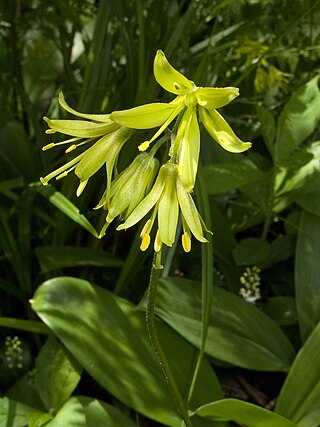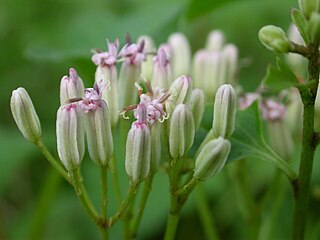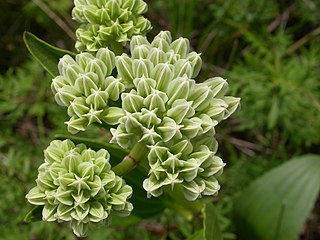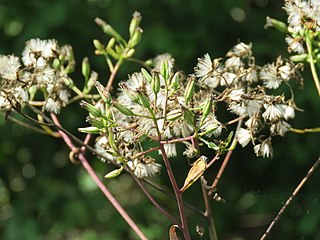
Asimina is a genus of small trees or shrubs described as a genus in 1763. Asimina is the only temperate genus in the tropical and subtropical flowering plant family Annonaceae. Asimina have large, simple leaves and large fruit. It is native to eastern North America and collectively referred to as pawpaw. The genus includes the widespread common pawpaw Asimina triloba, which bears the largest edible fruit indigenous to the United States. Pawpaws are native to 26 states of the U.S. and to Ontario in Canada. The common pawpaw is a patch-forming (clonal) understory tree found in well-drained, deep, fertile bottomland and hilly upland habitat. Pawpaws are in the same plant family (Annonaceae) as the custard apple, cherimoya, sweetsop, soursop, and ylang-ylang; the genus is the only member of that family not confined to the tropics.

Trillium is a genus of about fifty flowering plant species in the family Melanthiaceae. Trillium species are native to temperate regions of North America and Asia, with the greatest diversity of species found in the southern Appalachian Mountains in the southeastern United States.

Plantago is a genus of about 200 species of flowering plants in the family Plantaginaceae, commonly called plantains or fleaworts. The common name plantain is shared with the unrelated cooking plantain. Most are herbaceous plants, though a few are subshrubs growing to 60 centimetres tall.

Clintonia is a genus of flowering plants in the lily family Liliaceae. Plants of the genus are distributed across the temperate regions of North America and eastern Asia, in the mesic understory of deciduous or coniferous forests. The genus, first described by Constantine Samuel Rafinesque in 1818, was named for DeWitt Clinton (1769–1828), a naturalist and politician from the U.S. state of New York. For this reason, plants of the genus are commonly known as Clinton's lily. The common name bluebead refer to the distinctive fruit of members of the genus. Since fruit color varies somewhat across species, the common name bead lily is used as well.

Helianthus is a genus comprising about 70 species of annual and perennial flowering plants in the daisy family Asteraceae commonly known as sunflowers. Except for three South American species, the species of Helianthus are native to North America and Central America. The best-known species is the common sunflower. This and other species, notably Jerusalem artichoke, are cultivated in temperate regions and some tropical regions, as food crops for humans, cattle, and poultry, and as ornamental plants. The species H. annuus typically grows during the summer and into early fall, with the peak growth season being mid-summer.

Alisma is a genus of flowering plants in the family Alismataceae, members of which are commonly known as water-plantains. The genus consists of aquatic plants with leaves either floating or submerged, found in a variety of still water habitats around the world. The flowers are hermaphrodite, and are arranged in panicles, racemes, or umbels. Alisma flowers have six stamens, numerous free carpels in a single whorl, each with 1 ovule, and subventral styles. The fruit is an achene with a short beak.

Clintonia borealis is a species of flowering plant in the lily family Liliaceae. The specific epithet borealis means "of the north," which alludes to the fact that the species tends to thrive in the boreal forests of eastern Canada and northeastern United States.

Ditrysinia is a plant genus of the family Euphorbiaceae first described as a genus in 1825. It contains only one recognized species, Ditrysinia fruticosa, the Gulf Sebastian-bush, native to the southeastern United States.

Spiranthes is a genus of orchids in the subfamily Orchidoideae. They are known commonly as ladies tresses, ladies'-tresses, or lady's tresses. The genus is distributed in the Americas, Eurasia, and Australia. The genus name Spiranthes is derived from the Greek speira ("coil") and anthos ("flower"), and was inspired by the spirally arranged inflorescence.

Houstonia (bluet) is a genus of plants in the family Rubiaceae. Many species were formerly classified, along with other genera since segregated elsewhere, in a more inclusive genus Hedyotis.

The genus Cacalia L. is a nomen rejiciendum under the International Code of Nomenclature for algae, fungi, and plants. The type species C. alpina L. has been transferred to Adenostyles alpina (L.) Bluff & Fingerh., and the former species of Cacalia now reside in a few different genera.

Arnoglossum diversifolium is a North American species of Arnoglossum and the sunflower family. It is native to the southeastern United States, the states of Florida, Georgia, and Alabama.

Arnoglossum plantagineum also known as tuberous Indian-plantain, groovestem Indian plantain or Prairie Indian plantain, is a North American species of Arnoglossum in the sunflower family. The Latin specific epithet plantagineum refers to the leaves of the plant which are similar to those of a plantain.

Collinsonia is a genus of flowering plants in the family Lamiaceae. It is native to East Asia and eastern North America. It was named for the English botanist Peter Collinson (1694–1768) by Carl Linnaeus in Species Plantarum in 1753. It is in the tribe Elsholtzieae, a small tribe of only 5 genera. In order of their number of species, they are Elsholtzia, Mosla, Collinsonia, Perilla, and Perillula.

Ratibida is a genus of North American plants in the tribe Heliantheae within the family Asteraceae. Members of the genus are commonly known as prairie coneflowers or mexican-hat.
Arnoglossum floridanum, the Florida cacalia, is a Florida species of plants in the sunflower family.

Arnoglossum ovatum, the ovateleaf cacalia, is a species of plant in the sunflower family. It is native to the southeastern and south-central United States from southern North Carolina to Florida and eastern Texas.
Arnoglossum sulcatum, the Georgia Indian plantain, is a North American species of plants in the sunflower family. It is native to the southeastern United States in the states of Mississippi, Alabama, Georgia, and Florida.

Arnoglossum reniforme, the great Indian plantain, is a North American species of plants in the sunflower family. It is native to the central and east-central United States primarily in the Appalachian Mountains, the Ohio/Tennessee Valley, and the Mississippi Valley. There are additional populations in the east and farther west in Oklahoma.

Plantago virginica, common names hoary plantain and Virginia plantain, is a species of plant native to North America and introduced in Asia. It is listed as a special concern in Connecticut. The Kiowa use it to make garlands or wreaths for old men to wear around their heads during ceremonial dances as a symbol of health. It is commonly found within the continental United States in the majority of states along coastal areas and on roads, though has become an invasive species to eastern China after its introduction c. 1980. It is an annual plant, blooming around the month of May.


















